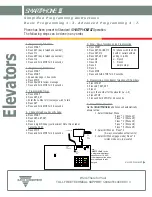
SDT 5000 User Manual
Document MBUD-0109v11
3 – Battery low (F) (G),
4 – Ignition asserted (H) (I),
5 – RTU buffer overflow (J),
6 – DTR asserted (L) (M),
7 – User generated event (N).
8 – Analog input event (P) (Q)
s
:
The state of the event where 1 is active, 0 is inactive. The following events
may be generated with s=0: Alarm 1, Alarm 2, Battery low, Ignition asserted,
and DTR asserted, Analog input less than, Analog input greater than.
Time
: The number of seconds since January 1, 1995.
CRC
: 16 bit CCITT CRC of X^16 + X^12 + X^5 + 1 over all fields of the message
excluding the CRC. The initial CRC value is set to all ones (0xFFFF). In a
received frame, if all the bytes of the frame plus the CRC bytes are subjected
to the CRC algorithm. The resulting value will be 0x0000 if there were no
errors. The CRC value is stored as “little endian”.
3.3 Output Signal Connections
The SDT 5000 support three output signals. The signals are a low side driver, high side driver, and a
Pulse Width Modulated (PWM) output.
The low side driver can sink up to 200 mA. The low side driver is controlled with the command
”output”, when the low side driver is on it will sink current (pull down). Example of the output
command:
>output out1 on
OK
>output out1 off
OK
The high side driver can supply up to 200 mA at VBAT volts. The high side driver is controlled with
the command “output”. When the high side driver is on it will source current (pull up). Example of
the output command:
>output out2 on
OK
>output out2 off
OK
The PWM output will output a signal 0 to 3.3 Volts, with a maximum current output of less than 100
uA. The PWM functionality is currently undefined.
Version 1.1, 03/24/06
Page 21
















































